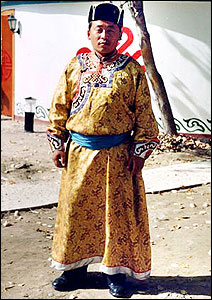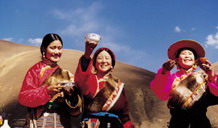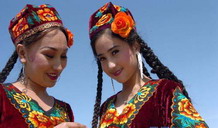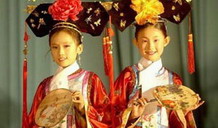The Mongolian Ethnic Group
History: The Mongolians in Xinjiang are descendents of the ancient Uirad Mongols. They moved to the north of the Tianshan Mountains as a consequence of Genghis Khan's western expedition in the early 13th century. In the early 15th century, the Mongolian community fell into the Woyela and Eastern Tartar groups. The Woyelas living north to the Gobi Desert included the tribes of Turhut, Durbot, Heshuot and Dzungar. These tribes were called Elut or Uirad in Chinese by the Qing Dynasty (1644-1911). They were nomadic herdspeople living in the area from northern Xinjiang to southeast of Balchas Lake. After the Qing court put down rebellions staged by Dzungarian nobles, the Eluts were enrolled as the Elut Camp in the Manchu "eight banner" military system. These people were later called Elut Mongolians. In 1771, the Turhut tribes, who had moved centuries before into the lower reaches of the Volga River and had a population of over 100,000, returned to China. The majority of their descendents currently live in areas such as Bayangolen, Bortala and Jinghe. In 1764 and 1813, the Qing government moved part of the Chahar Mongolian community to Xinjiang. Their offspring mainly live now in two counties – Bole and Wenquan – in Bortala Mongolian Autonomous Prefecture.
Economy: The majority of Mongolians in Xinjiang live on animal husbandry, although some have moved into food crop farming.
Diet: The Mongolians' staples include beef, mutton and wheaten foods. Wine brewed with cow or sheep milk is a popular beverage.
Culture: The Uirad epic Jianggar, treasured as one of the greatest epic works of China, is popular among Mongolians. One of the most well-known Mongolian musical instruments is "horse-head violin," a two-stringed instrument with a carved horse head. Xinjiang Mongolians also play the Tobshur, a two-stringed plucked instrument.

Holidays: Although Spring Festival is celebrated by Mongolians as the most important holiday, the annual Nadam Fair speaks more of their ethnic identity. The festival originated from their traditional Oboo (rock or earth altar) sacrifice.
Religion: Shamanism used to be the Mongolians' predominant religion. In the 16th century, they converted to the Yellow Sect of Lamaism, but the influence of Shamanism still can be seen.
Costume: Mongolian gowns made of sheepskin, silk or cotton is the traditional garment.
Marriage: Mongolians practice monogamy. Marriage within the same clan is strictly forbidden. Usually, marriage should involve proposing, engagement, the groom presenting gifts to the bride's family, and the wedding. There is a "house warming" ceremony on the third day of a wedding. The following day, the bride is supposed to go back and visit her parents. All these occasions are accompanied by singing and toasts.
Residence: Mongolian herdspeople live in movable felt yurts.
(China.org.cn August 25, 2005)
Editor: Feng Hui






